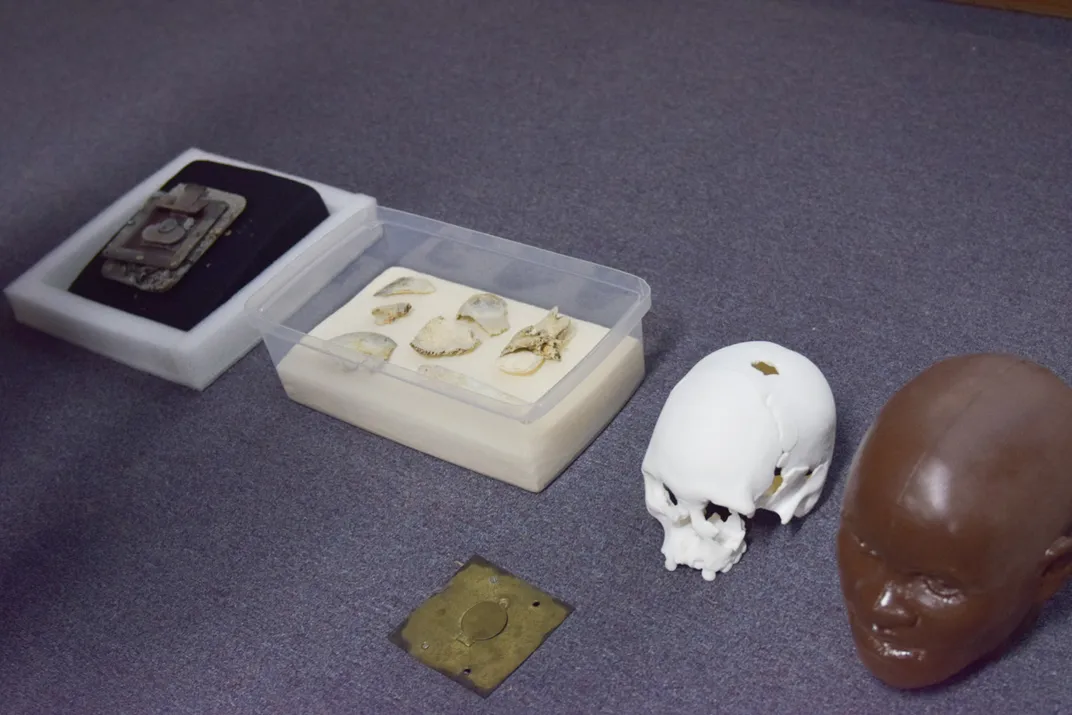Around 2,000 Artifacts Have Been Saved From the Ruins of Brazil’s National Museum Fire
Meanwhile, search attempts, which are expected to last through the end of 2019, continue
/https://tf-cmsv2-smithsonianmag-media.s3.amazonaws.com/filer/00/ac/00ac964e-a8bd-4e52-87c0-989e6b5123ac/screen_shot_2019-02-15_at_11455_pm.png)
Early last September, a devastating inferno blazed through Brazil’s National Museum, destroying the 200-year-old building and reducing the majority of its more than 20-million artifact collection to ashes.
As an array of recovery efforts launched over the past five months attest, the beloved Rio de Janeiro institution’s story is far from finished: Just two weeks after the fire, museum staffers gathered in the front of the burned building to host a temporary exhibition of surviving artifacts, and at the end of the year, Google Arts & Culture immortalized the pre-fire building in a comprehensive virtual tour. The museum even opened an exhibition in mid-January, titled When Not Everything Was Ice: New Discoveries in the Antarctic Continent, at the Museum of the Brazilian Mint, which served as the national institution’s home back in the 19th century.
Now, Julia Barbon and Angela Boldrini report for Brazilian daily Folha de S. Paulo, the razed site has temporarily reopened its doors to let the press survey the damage. All that remains of the imposing three-story structure, which once served as the official residence of the exiled Portuguese royal family, is the ground floor.
Scaffolding supports the burnt husks of former galleries, reinforcing the walls enough to ensure the safety of some 60 anthropologists, archaeologists and paleontologists tasked with sifting through the rubble. According to Agence France-Presse, the rescuers have spent roughly nine hours per day over six days a week searching for salvageable artifacts.
Back in December, Yesica Fisch of the Associated Press reported that researchers had recovered more than 1,500 fragments from the debris. Two months later, the number of retrieved artifacts is closer to 2,000, as Barbon and Boldrini report for Folha de S. Paulo.
Amongst the most significant items rescued from the flames are the 11,500-year-old skull of Luzia, the oldest human ever found in the Americas, and the Bendegó meteorite, a 5.8-ton space rock discovered in the Brazilian state of Bahia in 1784.
Archaeologists first unearthed Luzia’s skull in Brazil’s Lapa Vermelha in 1975. Believed to have been in her early 20s when she died, Luzia—named in honor of the Australopithecus afarensis specimen commonly known as Lucy—stood around 5 feet tall and belonged to an early hominin group that dined on nuts, fruits and berries.

Museum staff initially thought that Luzia’s remains had been destroyed by the fire. As the museum announced in late October, however, rescuers eventually recovered around 80 percent of Luzia’s skull fragments, as well as part of her femur.
Fisch notes for the AP that additional artifacts retrieved from the debris include fragments of indigenous Brazilian arrows, a Peruvian vase and a pre-Hispanic funeral urn. AFP further states that segments of a 44-foot Maxakalisaurus topai dinosaur skeleton, once heralded as the museum’s most popular attraction, were also found.
According to the National Museum’s “Post-Fire Rescue” portal, a second meteorite named after the municipality of Angra dos Reis, where it was found in 1869, survived the fire in a flame-resistant iron cabinet. Other objects listed as newly recovered include two karajás dolls, a semilunar ax from Maranhão, pink quartz, an amethyst and a black tourmaline crystal.
Claudia Carvalho, the archaeologist in charge of rescue efforts, tells Folha de S. Paulo that the team is working to collect, sort, catalogue, stabilize and restore rescued artifacts. Although staffers currently have 20 storage containers at their disposal, the institution says it will need double this amount as search attempts—expected to last through the end of 2019—continue.
For now, AFP reports that Brazilian authorities are pursuing two lines of inquiry: first, the unprecedented task of rebuilding the razed museum, and second, the cause of the blaze itself. In September, the Guardian’s Jonathan Watts, Dom Phillips and Sam Jones noted that the underlying factors suspected to be at play were severe budget cuts and outdated fire prevention systems; in the aftermath of the fire, tensions flared over the systemic under-funding and neglect of Brazil’s cultural institutions.
The tragedy in Brazil has triggered an outpouring of international support. As Gabriella Angeleti of the Art Newspaper wrote at the end of 2018, a partnership between the U.S. Diplomatic mission in Brazil, the Fulbright Commission, the U.S. Department of State and the Smithsonian Institution is set to give 14 scientists who lost their work in the flames an opportunity to continue research at the Smithsonian’s various labs. Governments and cultural organizations across the world have also pledged to offer financial backing for rebuilding efforts.
“It is important to stress that the National Museum, despite having lost a significant part of its collection, has not lost its ability to generate knowledge,” museum director Alexander Kellner wrote in open letter last year. He affirmed in the piece, “The National Museum lives!”
/https://tf-cmsv2-smithsonianmag-media.s3.amazonaws.com/accounts/headshot/mellon.png)
/https://tf-cmsv2-smithsonianmag-media.s3.amazonaws.com/accounts/headshot/mellon.png)